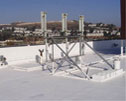The use of roof coatings is on the rise as a cost-effective, viable solution for weatherproofing roof systems and helping extend their service lives. Whether an asphalt-based or elastomeric coating is used, it's critical the coating is applied correctly to maximize roof system service life and minimize callbacks.
The most common types of roof coatings are bituminous-based (solvent-based) and polymer-based (water- or solvent-based). When applying a roof coating, be sure to use a product compatible with the substrate on which it will be used. Common substrates include polymer-modified bitumen sheets, single-ply membranes, built-up roof membranes and metal roof panels. Be sure to follow all applicable code requirements. Also, follow appropriate safety measures such as wearing safety glasses, gloves and any other personal protective equipment outlined in the product's material safety data sheet.
To select a roof coating, most manufacturers recommend roofing professionals use ASTM International- or code-compliant products at the proper application rate that meet the requirements of some or all of the following organizations:
- Miami Metro-Dade County
- Underwriters Laboratories Inc.
- FM Global
- Cool Roof Rating Council
- Title 24
- ENERGY STAR®
Although every roof system is different, there are general best practices to follow when applying coatings.
Prepare the substrate
Do
- Any repairs to the substrate should be made well in advance of coating application (48 hours for repairs using water-based materials and up to 30 days for repairs using asphaltic mastics).
- Surface preparation is a critical step when coating a substrate. The area should be clean and dry before coating application. To ensure a clean substrate, inspect the surface for debris and loose dirt, as well as any water near roof imperfections. If using a water-based coating, pressure wash the surface before coating application, and always blow or power broom a surface before applying solvent-based coatings.
- Prime the surface to promote adhesion if required by the coating manufacturer.
Don't
- Avoid pressure washing when using a solvent-based coating. Residue water trapped under the coating may result in blisters.
Solvent-based aluminum coatings
Do
- Always mechanically mix aluminum coatings with an electric drill with an appropriate mixing/stirring bit—rolling the pail on the ground or stirring with a stick do not count.
- Primer complying with ASTM D41, "Standard Specification for Asphalt Primer Used in Roofing, Dampproofing, and Waterproofing," should be used sparingly before coating application if needed. An option for aluminum roof coatings (water- or solvent-based) is using an asphalt clay emulsion for a base or primer coat.
- Apply the coating at the manufacturer's recommended coverage rate and number of coats.
- Fibrated coating should be applied using a brush or spray. If a roller is used improperly, it may push the fibers away from the coating, leaving the customer with few or no fibers in the coating.
- Nonfibrated coating should be applied using a roller or spray. If a brush is used for application, an uneven coating above the manufacturers' recommended application rate will occur.
- Always apply aluminum coatings in one direction; application in multiple directions will affect the coating's aesthetics because of changes in the pattern of the leafing aluminum paste.
- Use the appropriate spray tip for the specific product and application.
Don't
- Do not thin out the product.
- Do not apply over a wet coating or substrate.
Water-based aluminum coatings
Do
- If required, mix the coating.
- Apply the coating at the recommended coverage rate.
- Typically, water-based aluminum coatings are applied with one coat.
- Apply the coating using a brush, roller or spray.
- Use the appropriate spray tip for the specific product and application.
- Check for pin holes and thickness. Pin holes left unchecked will allow water to migrate under the coating, eventually causing blisters.
Don't
- Do not thin out the product.
- Do not apply over a wet membrane, substrate or coating.
Other bituminous non-aluminum coatings
Do
- If the coating is separated in its pail, mix it with an electric drill with an appropriate mixing/stirring bit—rolling the pail on the ground or stirring with a stick do not count.
- Primer complying with ASTM D41, "Standard Specification for Asphalt Primer Used in Roofing, Dampproofing, and Waterproofing," should be used sparingly before coating application if needed. An option for aluminum roof coatings (water- or solvent-based) is using an asphalt clay emulsion for a base or primer coat.
- Apply the coating at the manufacturer's recommended coverage rate and number of coats.
- Fibrated coating should be applied using a brush or spray. If a roller is used improperly, it may push the fibers away from the coating, leaving the building owner with few or no fibers in the coating.
- Nonfibrated coating should be applied using a roller or spray. If a brush is used for application, an uneven coating above the manufacturer's recommended application rate will occur.
- Use the appropriate spray tip for the specific product and application.
Don't
- Do not thin out the product.
- Do not apply over a wet coating or substrate.
Water- or solvent-based polymer coatings
Do
- If required, mix the coating.
- Apply the coating at the manufacturer's recommended coverage rate.
- Typically, elastomeric coatings are applied in two or three coats depending on the coating system's requirements; base, intermediate (if required) and finish coat(s) are used.
- Apply the coating using a brush, roller or spray.
- Use the appropriate spray tip for the specific product and application.
- For best results, each coat should be applied and allowed to dry overnight.
- Each consecutive coat should be applied perpendicular to the prior coat to help reduce pin holes and ensure adequate coverage.
- Check for pin holes and thickness. Pin holes left unchecked will allow water to migrate under the coating, eventually causing blisters.
Don't
- Do not thin out the product.
- Do not apply over a wet membrane, substrate or coating.
A correct installation
Whatever coating you choose to use, if you follow the manufacturer's recommended application instructions and the simple steps I provide, you can be assured the result will be a roof system you can be proud of and your customer will appreciate.
Mark Raneiri is a coatings specialist for Polyglass® USA Inc., Deerfield Beach, Fla.



